
A Guide to California's
Reptiles and Amphibians
Sounds of
Northern Red-legged Frog - Rana aurora
Baird and Girard, 1852
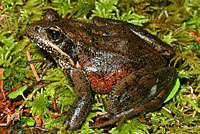 Adult frog
Adult frog
More pictures and information:
California
Northwest
|
Male frogs and toads sometimes make a variety of sounds. These calls can have different functions. Advertisement Calls The advertisement call is the most well-known call of a frog or toad. It is made by a male during the breeding season to establish his territory and repel rival males and to attract females as potential mates. Males usually make the call in or near bodies of water near areas that are attractive to a female as a good place to lay her eggs. Advertisement calls can be heard during the evening and at night, and often during daylight at the peak of the breeding season. Sometimes an advertisement call will be heard outside of the breeding season and away from water. The reason for this is not understood. Each species has its own unique advertisement call. This is necessary to differentiate them when there is more than one species calling. The evolution of this specific male advertisement call and its recognition by females is considered to be an important isolating mechanism in the evolution of a species. Rana aurora has been observed calling during every month of the year, and sometimes a male frog will call from land instead of from underwater. The reason for these calls are not known. "Vocalization by male R. a. aurora [now known as R. aurora] from concealed locations outside of the breeding season may be commonplace." (Marc P. Hayes, Charleen B. Hayes & Joanne P. Schuett-Hames. Herpetological Review 35(1), 2004) The vocalizations of Rana aurora can be described as a very quiet weak series of 5 - 7 notes, sounding like uh-uh-uh-uh-uh, lasting 1 - 3 seconds. Calls are made during the day or night for only one or two weeks at a location. Calls are made underwater and are easily missed. They may also be made in the air. |
||
| In-Air Advertisement Call Recordings | ||
The following recordings were made from 1 to 3 PM on a partly cloudy day in Lewis County Washington in early February. Air temperature was 50 degrees. The elevation was approximately 200 ft. All sounds were recorded in the air (not underwater) at a close distance with a shotgun microphone. The habitat (shown below) was a small overflow pool beside a creek flowing next to fallow agricultural fields in a narrow valley surrounded by forested hills. Several R. aurora egg masses were floating in the water, or attached to grass. Pictures of these eggs can be seen here. The frogs called from hidden locations underneath vegetation in the water or at the edge of the water. The frogs were probably calling from underwater or with their heads just barely out of the water. The calls were very faint, only audible from a few feet away, and infrequent, lasting only for a few seconds between long stretches of silence. Background sounds include: various birds calling and moving around in dry reeds, including ravens and song sparrows; flowing water; distant traffic; and distant farm equipment. |
||
| This is a 5 second recording of the advertisement calls of a single frog. | ||
| This is a 37 second recording of the advertisement calls of a single frog. The loud call note of a Song Sparrow is heard in the second half. | ||
| This is a 72 second continuous recording of a few frogs calling or chuckling rapidly - a faster and higher-pitched sound from the typical calls which can be heard above. | ||
| This is a 9 second recording of a frog making rapid chuckling and squeaking sounds. (This does not appear to be an advertisement call, so it might be some type of release or encounter call.) A Song Sparrow is singing in the background. | ||
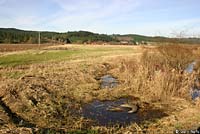 |
||
| Underwater Advertisement Call Recordings | ||
The following recordings were made during an afternoon in early March in an artificial pond in Humboldt County. The air temperature was about 50 degrees, with sun and scattered clouds. Even though one of the calling frogs was visible about a foot below the surface of the water - see the picture below - no sounds were heard in the air. All sounds were recorded with a hydrophone, which is an underwater microphone. |
||
| This is a 26 second continuous underwater recording of the advertisement calls of a single frog - shown above on the left on the bottom. | ||
| This is a 27 second continuous underwater recording of the advertisement calls of a single frog. | ||
| This is a 42 second continuous underwater recording of two or three frogs which appear to be reacting to each other with chuckling and grunting sounds. | ||
| This is a 14 second continuous recording of two frogs calling and chuckling. | ||
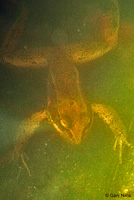 |
||
The following recordings were made at the same location as above in Lewis County, Washington in mid February using a hydrophone placed only a few inches below the surface. These calls were barely audible in the air, and were very faint underwater, as far as I could determine. 6 or 7 frogs were calling from the area, but the calls were infrequent with long stretches of silence between them. None of the frogs were seen - they were all hidden somewhere in vegetation. |
||
| This is a 2 second underwater recording of the advertisement calls of a single frog. |
||
| This is an unedited 21 second underwater recording of a series of 3 advertisement calls of a single frog. | ||
| This is a 47 second underwater recording of the advertisement calls of one or more frogs. The time has been shortened: the original recording was much longer and much of the silence between calls has been removed. | ||
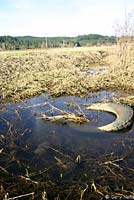 |
||
| Release Call The release call is made by a frog when another male frog attempts to clasp its back in amplexus. A frog will also produce this call when it is grabbed across the back by a human, and probably also when it is grabbed by other types of predators. |
||
| This is a release call made when a calling male frog was picked up out of the water and grasped across his back in Humboldt Couny. Recorded in the air, not underwater. | ||
| Waveform and Sonogram | ||
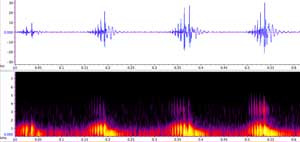 |
||
| This is a recording of the advertisement calls of a Northern Red-legged Frog recorded underwater in Humboldt County. The image above is a visual representation of this call. Click on it to see a larger image. Click here for information about how to read the waveform and sonogram images. |
||
You can listen to more recordings of Northern Red-legged Frogs on this cd: Carlos Davidson - Frog and Toad Calls of the Pacific Coast 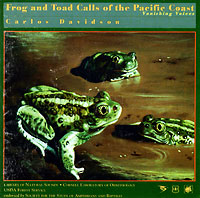 and on the cd that comes with this book: Lang Elliott, Carl Gerhardt, and Carlos Davidson - The Frogs and Toads of North America - Houghton Mifflin Harcourt. 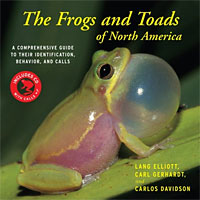 |
||
Return to the Top
© 2000 -